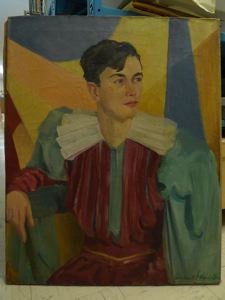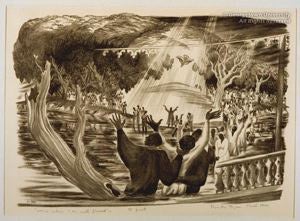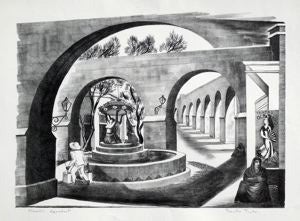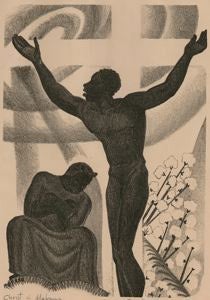Prentiss Taylor – An Appreciation
Prentiss Taylor’s inspiration has always been drawn from the interests and concerns of cultivated man—especially architecture, music, and social justice—and from man’s relationship to environment and landscape. His subjects range from the grand to the common. While human figures seldom appear in his landscapes, the interaction of man and landscape is implicit, and vestiges of man’s past are usually present—a Roman aqueduct, an Indian cliff dwelling, a church at Trampas.
Although his work has always been figurative and seemingly realistic, Taylor does not hesitate to alter or rearrange reality for its own good and for the enhancement of his design. His earlier work often employed deliberate distortion in order to achieve a synthesis of the various elements of a scene, controlled primarily by an overall design concept, a kind of arrangement and summary of a scene by collection and formally organizing its separate elements.
In the course of time, he refined these distortional techniques considerably, especially in his landscapes. Instead of arbitrarily combining selected elements of a scene into a formal conceptual arrangement, he developed an approach of changing focus or viewpoint.
As Taylor himself explained it on the occasion of an exhibit in 1951, “I have walked around the landscape you are looking at…I have looked at the buildings close to and then seen them in the entire landscape This is simple This is what everyone’s eye does. The eye does not comprehend a whole scene. It roves. And it is this shifting viewpoint that I exploit to emphasize the elements of a scene that will express my conception of it. Consequently, the scene is at once more naturally represented than by the synthesis method and yet not restricted to the camera-eye or fixed viewpoint.”
It is the artist’s lithographs that summon forth and display his greatest skills. Practically in a class by themselves are his prints drawn on stone with brush and lithographic ink instead of crayon. Sometimes called “lithoprints,” they permit great spontaneity of creation, but demand the utmost virtuosity and experience. Once the ink is diluted in order to obtain halftones and other tonal gradations of a wash drawing, it becomes extremely difficult to handle with confidence in the outcome. There are a number of outstanding lithoprints in this show.
Characteristic of Taylor’s work is careful and thoughtful composition, including clarity of design, rhythm, space, and tonal values. He is concerned not just with balance, but, above all, with movement, the use of design elements to carry the eye across and around the work.
Prentiss Taylor explores and exploits all the textural possibilities of the lithographic stone with assurance, virtuosity, and authority, distilling the experiences of a man of great sensitivity, broad interests, and discriminating taste, who is concerned above all with man’s place in nature and time.
Donald Volger
[Condensed from The Washington Print Club Newsletter, Winter 1980-81]
Prentiss Taylor—Biographical Notes
In 1927 the Arts Club of Washington hosted the first exhibition to include the works of Prentiss Taylor, a third generation Washingtonian born December 13th, 1907. In announcing the exhibition, the Club declared that this remarkable young artist had “a brilliant future ahead of him.” Now, more than sixty years later, we witness the complete fulfillment of that judgment in this Georgetown exhibition.
Taylor began the study of lithography at New York’s Art Students League in 1931, finding that the medium gave him great satisfaction. As he was to comment on it many years later, “with that first magic feeling of the lithograph crayon working on the fine grain of the stone, I knew that I was at home in lithography.”
In 1934, after fellowships at the MacDowell Colony and at Yaddo, the MacBeth Gallery gave Taylor his first one-person exhibition in New York City. In 1942 he became the President of the Society of Washington Printmakers (an office he was to hold for the next 34 years) and in 1948 he was elected an associate of the prestigious National Academy of Design.
One of Taylor’s most interesting projects was his collaboration with the late Langston Hughes, the noted black author. With the encouragement of the writer Carl Van Vechten, Hughes and Taylor joined forces towards the end of 1931 to create the Golden Stair Press, issuing broadsides and books with illustrations by Taylor and texts by Hughes. Among their joint publications are The Negro Mother and Other Dramatic Recitations and the powerful Scottsboro Limited.
The subject of art and psychiatry is one in which the artist has also been deeply interested. From 1943 to 1954 Taylor served as art therapist on the staff of St. Elizabeth’s Hospital in Washington, and later with the staff of Chestnut Lodge in Maryland. In addition, the February 1950 issue of the American Journal of Psychiatry carried his important contribution to the literature, “Art as Psychotherapy.”
Over the years Taylor has travelled much and exhibited widely, both in this country and abroad. His work has been shown at the Art Institute in Chicago, the Metropolitan Museum of Art, the Whitney, the Philadelphia Museum of Art, the Museum of Fine Arts in Boston, and at the Library of Congress, to name a few. As early as 1937 he was shown at the American Pavilion of the Paris Exposition, and again in 1940 at the Venice Biennial. In many of these exhibitions his works have won prizes and awards for their excellence. Today he is represented in the permanent collections of many of the country’s leading museums.
Prentiss Taylor lives in comfortable retirement in his Northwest Washington home amid his art and his books, reminiscing with old friends, former students and admirers who come by in search of the wisdom and advice of one of America’s outstanding graphic artists.
Catalog
The catalog follows the order in which Prentiss Taylor’s works appear in this exhibition, i.e., beginning with the trios of prints installed in the six wall cases along the gallery’s south wall. These are followed by the four table cases along the gallery’s north wall and on to the large table case near the gallery entrance. The catalog concludes with the framed prints, oils and watercolors hung about the gallery.
All works listed in the catalog are lithographs, except where the entry is preceded by an asterisk and goes on to identify the work as a watercolor, oil, drawing, etc. Unless otherwise noted, all works are from the collection of the artist.

Prentiss Taylor – A Look Back
After the Picnic, 1952
Ed. 15, LXXXIV, 286 x 225mm.
Portrait of the artist Louise Emerson
Negro Head, 1931
Ed. 10, I, 233 x 240
Prentiss Taylor’s 1st lithograph
Myself as Mezzetin, 1936
Ed. 40, XLVI, 326 x 223
Self portrait with memorabilia, including a cross section of TVA’s Norris Dam
James Elder Collection, Georgetown Univ.
New England Ethos
Roxbury Foundry, 1934
Ed. 25, XL, 360 x 249
Connecticut Light & Power, 1935
Ed. 40, XLIV, 248 x 378
Louisburg Square, 1933
Ed. 20, XXVII, 350 x 245

Revelation
Assembly Church, 1936
Ed. 40, XLVIII, 243 x 341
The Jude Howard Collection
“…In Whom I Am Well Pleased”, 1940
Ed. 35, LVIII, 266 x 383
Experience Meeting, Massydony, 1934
Ed. 25, XXXIX, 233 x 338
Il. In CRISIS (NAACP), August, 1934
Southern Exposure
Horlbeck Alley, 1934
Ed. 20, XXXIII, 231 x 341
Il. In CRISIS (NAACP), July, 1934
Carolina Low Country, 1933
Ed. 20, XXX, 349 x 253
Il. In CRISIS (NAACP), March 1934
Watermelon Wagon, 1947
Ed. 30, LXXIII, 168 x 274
Georgetown University Collection
Music – Practice & Performance
Feldman Quartet Rehearsing, 1967
Ed. 17, CXVIII, 232 x 322
At the National Gallery of Art
Seated Serenade, 1947
Ed. 30, LXXV, 315 x 233
Hungarian Quartet, 1953
Ed. 20, XC, 253 x 367
Architectural Byways
New Hampshire Barn, 1933
Ed. 10, XXVIII, 255 x 358
St. Helena’s, Beaufort, 1934
Ed. 25, XXXVIII, 350 x 285
Sedgwick House & Details, 1935
ed. 40, (26 printed), XLIII, 235 x 348
Going West
Morning Light, Telluride, 1961
Ed. 25, CII, 294 x 411
Clliff & Ruin – Canyon de Chelly, 1976
Ed. 75, CXXVIII, 377 x 253
Georgetown University Collection
Towards Santa Fe, 1958
Ed. 25, XCVIII, 302 x 397
Il. In Adams, Clinton. Printmaking in New Mexico, 1990

Mexico
j, 1941
Ed. 35, LX, 266 x 370
Georgetown University Collection
Paletas, 1941
Ed. 30, LIX, 347 x 193
Morelia Aqueduct, 1942
Ed. 35, LXII, 280 x 380
Il. In Reese, Albert. American Prize Prints of the 20th Century.
Bridges
The Bridge, Sunday, 1952
Ed. 25, LXXXII, 302 x 427
The Brooklyn Bridge, New York City
From Rosslyn to Georgetown, 1955
Ed. 30, XCIII, 311 x 453
Summer Conversation, 1952
Ed. 15, LXXXIII, 319 x 412
Along New Jersey Ave, Washington, DC
Boats
Supper in Port, 1937
Ed. 35, LIII, 251 x 330
Il. In Fine Prints of the Year, 1938
High & Dry, 1936
Ed. 129, XLVII, 352 x 253
The Am. Artists Group edition of Rocky Neck Railways, 1935, ed. 25
Georgetown University Collection
Shrimp Boats, Okracoke, 1958
Ed. 25, XCVII, 285 x 400
In The Caribbees
San Juan Recollection, 1937
Watercolor, 255 x 183
Southern Cross, St. Thomas, 1937
Ed. 35, L, 305 x 252
Going on Before, 1937
Watercolor, 280 x 200
Lent by Bob Stana & Tom Judy
Night Shadows
The Service Club, 1939
Ed. 35, LV, 267 x 362
Sunday Night at the Plaza, 1961
Ed. 25, CI, 335 x 420
Black on Black, Pittsburgh, 1948
Ed. 30, LXXVI, 257 x 353
Mostly Miniatures
4 Sq” of Utter Disrespect for the Square, 1966
Ed. 20, CXII-A, 52 x 52
Nameplate, 1932
Ed. 12, X, 255 x 154
Pennsylvania Station Demolition, 1966
Ed. 20, CXII-C, 47 x 58
Flamenco, 1967
Ed. 30, CXVII-A, 28 x 89
Juilliard Playing Webern
Preliminary drawing for print below
Juilliard Playing Webern, 1970
Ed. 40, CXX-B, 42 x 62
Early Music, 1970
Ed. 40, CXX-A, 58 x 44
Early Music, preliminary drawing for above print
Lutanist II, 1967
Ed. 30, CXVII-B, 45 x 56
Stones, Great & Small
At George C. Miller & Son – Lithographers, 1961
No ed. CIII, black only, 282 x 750
At George C. Miller & Son – Lithographers, 1961
Ed. 20, CIII, 282 x 750
At George C. Miller & Son – Lithographers II, 1966
Ed. 20, CXII-D, 32 x 87

The Scottsboro Case
Christ in Alabama, 1932
Ed. 45, XXII, 223 x 155
8 Black Boys, 1932
Ed. 40, XXIII, 225 x 158
Scottsboro Limited, a book of four poems and a play in verse by Langston Hughes, with illustrations by Prentiss Taylor.
NY: The Golden Stair Press, 1932.
This is #5 of a limited edition of 30 copies with Prentiss Taylor’s four lithographs tipped in.
Taylor and Hughes established The Golden Stair Press in 1931 to publish Hughes’ earlier work, The Negro Mother.
Scottsboro Limited, 1932
Ed. 80, XXIV, 206 x 156
Town of Scottsboro, 1932
Ed. 42, XXV, 218 x 141
An Ageless Vision
Segovia Aqueduct II, 1970
Ed. 25, CXIX, 350 x 447
Academy Self-Portrait, 1949
Ed. 25, LXXXVIII, 392 x 250
Membership print, Nat’l Academy of Design
James Elder Collection, Georgetown Univ.
The Church at Trampas, 1983
Ed. 50, CXXXVII, 375 x 472
Prentiss Taylor’s last lithograph
Book Work, Etc.
Designs for Printed Papers, late 1920’s
A pair of ink drawings, 152 x 152mm, & 140 x 127mm.
Book Jacket, c.1929
For Valerian Tornius’ Solons
Published NY: Cosmopolitan Book Corp. 1929
Color lithographic proof
Book Jacket, c. 1929
For Shirley Watkins’ This Poor Player
Published Phila.: Macrae-Smith Co. 1929
Color lithographic proof
Book Jacket, c. 1932
For Carl Van Vechten’s Sacred & Profane Memories
Published NY: A.A. Knopf, 1932
Color lithographic proof
Book Jacket, c. 1934
For France Frost’s Women of this Earth
Published NY: Houghton Mifflin Co., 1934
Color lithographic proof
Washington Landmarks No. I: Birthplace of Prentiss Taylor [1735 F. Street, NW]
Ink drawing, 489 x 178mm, early 1920’s
Framed Works on Walls
Cottonwoods in Canyon de Chelly, 1963
Ed. 15, CVI, 342 x 533
Romans in England, 1967
Ed. 30, CXIV, 417 x 557
Salem Station, 1937
Watercolor, 236 x 330
Charles Town Paddock, 1956
Oil on canvas, 14 x 28”
River Boats, Mist and Steam, 1953
Oil on canvas, 20 x 26”
Swing Low Sweet Chariot, 1932
Ink & watercolor on paper, 279 x 160mm
Georgetown Floating World, 1958
Oil on canvas, 12 x 36”
From the collection of Donn B. Murphy
Co-sponsored by Georgetown University and The Washington Print Club
